Papers by Dr. Bradley Walker
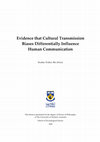
First, I would like to thank my supervisors Nic Fay and Mark Ellison, for the guidance, the patie... more First, I would like to thank my supervisors Nic Fay and Mark Ellison, for the guidance, the patience, and (not least) for the employment. I look forward to future collaborations! My gratitude to Kira McPherson, who specifically asked to be thanked "for the light and the love," but (and), more pertinently, proofread every chapter. Thanks also to Casey Lister for her useful comments. To Alan Bailey, Shane Rogers, Lauren Hollier (now Lawson-a fun tidbit for future genealogists) and Michael Wilson, who rated subsets of the similarity comparisons so that I could measure inter-rater reliability-thank you for your service. Thanks to the PSYC3310 students who helped with testing, and especially to all of the participants who made this research possible! I hope you found it interesting, or at least enjoyed telling your friends about the crazy experiment where you drew a picture of Russell Crowe throwing a telephone at a hotel concierge. To all the past and present members of the Social Influence (née Communication) Lab, to my (now mostly departed) postgrad colleagues, and to my various officemates, thank you for your support, and for many fun and interesting conversations. To my friends and family members, with their varied knowledge of what exactly I have been doing and whether or not I have finished doing it, this is it (though I don't expect you to read it), and yes I have. Thank you for your feigned or actual interest over the years! This research was supported by an Australian Postgraduate Award (APA), which replaced a University Postgraduate Award (UPA), and also a UWA Top-Up Scholarship. To any doubters, and to the various people (Lauren, Casey, Michael…) whom I casually planned to submit with, but then didn't, I end on an excerpt from a play that I co-wrote while not working on my thesis. FLINT WESTWOOD: You finally did it. ATHENA: Yes, I finally proved you wrong about me not doing it yet.
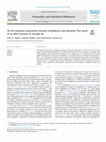
Personality and Individual Differences, Nov 1, 2020
The linear association between intelligence and openness has been estimated at r ≈ 0.20 to 0.30. ... more The linear association between intelligence and openness has been estimated at r ≈ 0.20 to 0.30. However, little research has examined the possibility of a nonlinear effect between the two dimensions. Consequently, taskbased intelligence and self-reported openness data were collected from 371 participants (UK community sample). We found that the association was nonlinear, i.e., the positive effect was no longer observed beyond an IQ of ≈ 105. Furthermore, across the 10 openness items, four evidenced positive, linear effects with intelligence, all of which were epistemic openness items. By comparison, several experiential openness items showed inverted U-shaped effects. It is concluded that, beyond relatively low to moderate levels of intelligence, general intelligence may be unrelated to global openness, especially if need for cognition is considered distinct from openness.

Behavior Research Methods, Jul 11, 2023
Given the potential negative impact reliance on misinformation can have, substantial effort has g... more Given the potential negative impact reliance on misinformation can have, substantial effort has gone into understanding the factors that influence misinformation belief and propagation. However, despite the rise of social media often being cited as a fundamental driver of misinformation exposure and false beliefs, how people process misinformation on social media platforms has been under-investigated. This is partially due to a lack of adaptable and ecologically valid social media testing paradigms, resulting in an over-reliance on survey software and questionnaire-based measures. To provide researchers with a flexible tool to investigate the processing and sharing of misinformation on social media, this paper presents The Misinformation Game-an easily adaptable, open-source online testing platform that simulates key characteristics of social media. Researchers can customize posts (e.g., headlines, images), source information (e.g., handles, avatars, credibility), and engagement information (e.g., a post's number of likes and dislikes). The platform allows a range of response options for participants (like, share, dislike, flag) and supports comments. The simulator can also present posts on individual pages or in a scrollable feed, and can provide customized dynamic feedback to participants via changes to their follower count and credibility score, based on how they interact with each post. Notably, no specific programming skills are required to create studies using the simulator. Here, we outline the key features of the simulator and provide a non-technical guide for use by researchers. We also present results from two validation studies. All the source code and instructions are freely available online at https:// misin fogame. com.
Journal of Bacteriology, Jun 1, 1970

AMB Express, Jan 24, 2018
There has been continued interest in bacteriocins research from an applied perspective as bacteri... more There has been continued interest in bacteriocins research from an applied perspective as bacteriocins have potential to be used as natural preservative. Four bacteriocinogenic lactic acid bacteria (LAB) strains of Lactobacillus curvatus (Arla-10), Enterococcus faecium (JFR-1), Lactobacillus paracasei subsp. paracasei (JFR-5) and Streptococcus thermophilus (TSB-8) were previously isolated and identified in our lab. The objective of this study was to determine the optimal growth conditions for both LAB growth and bacteriocins production. In this study, various growth conditions including culture media (MRS and BHI), initial pH of culture media (4.5, 5.5, 6.2, 7.4 and 8.5), and incubation temperatures (20, 37 and 44 °C) were investigated for LAB growth measured as optical density (OD), bacteriocin activity determined as arbitrary unit and viability of LAB expressed as log CFU ml −1. Growth curves of the bacteriocinogenic LAB were generated using a Bioscreen C. Our results indicated that Arla-10, JFR-1, and JFR-5 strains grew well on both MRS and BHI media at growth temperature tested whereas TSB-8 strain, unable to grow at 20 °C. LAB growth was significantly affected by the initial pH of culture media (p < 0.001) and the optimal pH was found ranging from 6.2 to 8.5. Bacteriocin activity was significantly different in MRS versus BHI (p < 0.001), and the optimal condition for LAB to produce bacteriocins was determined in MRS broth, pH 6.2 at 37 °C. This study provides useful information on potential application of bacteriocinogenic LAB in food fermentation processes.
Child Development, May 12, 2021
Naturalistic studies show that children can create language‐like communication systems in the abs... more Naturalistic studies show that children can create language‐like communication systems in the absence of conventional language. However, experimental evidence is mixed. We address this discrepancy using an experimental paradigm that simulates naturalistic sign creation. Specifically, we tested if a sample of 6‐ to 12‐year‐old children (52 girls and 56 boys drawn from an urban, predominantly white population in Western Australia) can comprehend and create novel gestural and vocal signs. Experiment 1 tested children’s ability to comprehend novel signs. Experiment 2 tested children’s ability to create novel signs. Results show that children can comprehend and create gestural and vocal signs, that communication is more successful in the gesture modality, and that older children outperform younger children.

Cognitive Science, Feb 1, 2020
Recent research indicates that interpersonal communication is noisy, and that people exhibit cons... more Recent research indicates that interpersonal communication is noisy, and that people exhibit considerable insensitivity to problems in communication. Using a dyadic referential communication task, the goal of which is accurate information transfer, this study examined the extent to which interlocutors are sensitive to problems in communication and use other‐initiated repairs (OIRs) to address them. Participants were randomly assigned to dyads (N = 88 participants, or 44 dyads) and tried to communicate a series of recurring abstract geometric shapes to a partner across a text–chat interface. Participants alternated between directing (describing shapes) and matching (interpreting shape descriptions) roles across 72 trials of the task. Replicating prior research, over repeated social interactions communication success improved and the shape descriptions became increasingly efficient. In addition, confidence in having successfully communicated the different shapes increased over trials. Importantly, matchers were less confident on trials in which communication was unsuccessful, communication success was lower on trials that contained an OIR compared to those that did not contain an OIR, and OIR trials were associated with lower Director Confidence. This pattern of results demonstrates that (a) interlocutors exhibit (a degree of) sensitivity to problems in communication, (b) they appropriately use OIRs to address problems in communication, and (c) OIRs signal problems in communication.
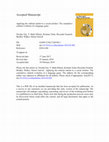
Evolution and Human Behavior, May 1, 2018
Material artefacts evolve by cumulative cultural evolution (CCE), the accumulation of adaptive mo... more Material artefacts evolve by cumulative cultural evolution (CCE), the accumulation of adaptive modifications over time. We present a large-scale experiment investigating the CCE of a social artefact in transmission chains, each containing 8 adult human participants (N=408). The social artefact is what Wittgenstein calls a 'language game', the subset of language used to perform a particular activity; in the present study the language game is to communicate a route on a map. Two social learning conditions were compared: Observational Learning and Social Coordinative Learning. Participants tried to accurately communicate a route on a map to the next person in their transmission chain. Over the experimental generations the routes were reproduced with progressively higher accuracy in both conditions, demonstrating the CCE of the language game. The rate of CCE was comparable across conditions, but route reproduction accuracy was consistently higher in the Social Coordination condition compared to the Observation condition. In both conditions performance improved due to the accumulation of adaptive patterns of verbal route descriptions, and the progressive elimination of non-adaptive patterns. Whereas change in the content of the language game was similar across conditions, change to the communication process differed between the Observation and Social Coordination conditions. In conclusion, like material artefacts, social artefacts, in our case the language game, evolve by cumulative cultural evolution.
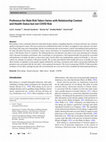
Evolutionary Psychological Science, Feb 22, 2023
Risk taking is more commonly shown by males than females and has a signalling function, serving t... more Risk taking is more commonly shown by males than females and has a signalling function, serving to advertise one's intrinsic quality to prospective mates. Previous research has established that male risk takers are judged as more attractive for shortterm flings than long-term relationships, but the environmental and socioeconomic context surrounding female preferences for male risk takers has been overlooked. Using a survey instrument, we examined female preferences for male risk takers across 1304 females from 47 countries. We found preferences for physical risk takers to be more pronounced in females with a bisexual orientation and females who scored high on risk proneness. Self-reported health was positively associated with preferences for high risk takers as short-term mates, but the effect was moderated by country-level health, i.e. the association was stronger in countries with poorer health. The security provided by better health and access to health care may allow females to capitalise on the genetic quality afforded by selecting a risk-prone male whilst concurrently buffering the potential costs associated with the risk taker's lower paternal investment. The risk of contracting COVID-19 did not predict avoidance of risk takers, perhaps because this environmental cue is too novel to have moulded our behavioural preferences.
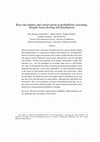
Judgment and Decision Making, Sep 1, 2022
Bayesian statistics offers a normative description for how a person should combine their original... more Bayesian statistics offers a normative description for how a person should combine their original beliefs (i.e., their priors) in light of new evidence (i.e., the likelihood). Previous research suggests that people tend to underweight both their prior (base rate neglect) and the likelihood (conservatism), although this varies by individual and situation. Yet this work generally elicits people's knowledge as single point estimates (e.g., x has 5% probability of occurring) rather than as a full distribution. Here we demonstrate the utility of eliciting and fitting full distributions when studying these questions. Across three experiments, we found substantial variation in the extent to which people showed base rate neglect and conservatism, which our method allowed us to measure for the first time simultaneously at the level of the individual. We found that while most people tended to disregard the base rate, they did so less when the prior was made explicit. Although many individuals were conservative, there was no apparent systematic relationship between base rate neglect and conservatism within individuals. We suggest that this method shows great potential for studying human probabilistic reasoning.

People copy one another’s utterances during communication (Garrod & Anderson, 1987). In labor... more People copy one another’s utterances during communication (Garrod & Anderson, 1987). In laboratory micro-societies this copying leads to the creation of shared communication systems (Fay, Garrod, Roberts, & Swoboda, 2010). If biased copying is seen in human communication, such that some individuals are more likely to be copied than others, certain individuals will have a disproportionate influence on the evolution of their communication system. People copy others they perceive to be skilful, successful, prestigious or similar to themselves (Henrich & McElreath, 2003; Richerson & Boyd, 2005). The present study tested whether people exhibit biased copying in a communication task similar to the game PictionaryTM. It is hypothesized that participants will copy the drawings of others more when told the drawer was skilful, successful, prestigious or similar to themselves (than when told the opposite).
Dialogue, Oct 1, 2003
In "Moving Zion Southward, Part II," I noted that from 1985-2000, average LDS church cash donatio... more In "Moving Zion Southward, Part II," I noted that from 1985-2000, average LDS church cash donations to humanitarian aid were $20 million annually.1 An "alert reader," as Dave Barry would say, has pointed out that since 2000 humanitarian donations have actually jumped to the range of $100 million per year. This fact is not published on the church internet site and verification required a phone call to LDS Welfare Services to obtain a "fact sheet" documenting the growth in giving. The church has not
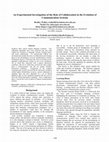
Conference Cognitive Science, 2009
Imitation alone cannot explain language evolution. Two additional ingredients have been proposed ... more Imitation alone cannot explain language evolution. Two additional ingredients have been proposed that may help explain the evolution of language systems: learning biases and social collaboration. An experimental method was developed that isolated the roles of collaboration and learning biases in the development of novel communication systems. Participants played a Pictionary-like task to develop ad hoc graphical communication systems in one of two conditions: one in which they interacted with a partner (Interaction condition), and one in which they received the same images from a "pseudo-partner" but did not interact (Pseudo-Interaction condition). Comparison of the resultant communication systems showed that the Interaction condition yielded higher identification accuracy, greater refinement of graphical signs and more alignment on a set of shared graphical signs (in fact, graphical alignment did not occur at all in the Pseudo-Interaction condition). Thus, collaboration plays a crucial role in the evolution of human communication systems.
Acta Crystallographica, Aug 23, 2015
The Evolution of Language, Apr 3, 2014
Majority influence is well established in social psychology. Boyd and Richerson (1985) proposed a... more Majority influence is well established in social psychology. Boyd and Richerson (1985) proposed a frequency-dependent bias in cultural transmission, such that the frequency of a behaviour is used as an indirect measure of its merit and affects its likelihood of adoption. Such a bias may affect the evolution of language, and may have done so for millennia, by influencing how linguistic variants spread through populations. The present study tested whether the frequency of signs in an experimentalsemiotic communication task (similar to Fay et al., 2010; Garrod et al., 2007) influenced the degree to which they were copied. It was hypothesized that majority signs would be copied more than minority signs.
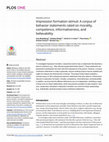
PLOS ONE, Jun 3, 2022
To investigate impression formation, researchers tend to rely on statements that describe a perso... more To investigate impression formation, researchers tend to rely on statements that describe a person's behavior (e.g., "Alex ridicules people behind their backs"). These statements are presented to participants who then rate their impressions of the person. However, a corpus of behavior statements is costly to generate, and pre-existing corpora may be outdated and might not measure the dimension(s) of interest. The present study makes available a normed corpus of 160 contemporary behavior statements that were rated on 4 dimensions relevant to impression formation: morality, competence, informativeness, and believability. In addition, we show that the different dimensions are non-independent, exhibiting a range of linear and non-linear relationships, which may present a problem for past research. However, researchers interested in impression formation can control for these relationships (e.g., statistically) using the present corpus of behavior statements.











Uploads
Papers by Dr. Bradley Walker